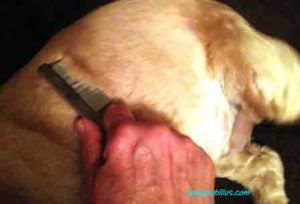Often I ignore the bombardment of ads for flea and tick control products and stay with my usual practice. But every once in a while something changes; my vet makes a recommendation, my pet develops an illness, or I hear new claims or concerns, that make me re-visit this issue.
Until fifteen years ago, I mostly did mechanical control with frequent monitoring and cleaning. Back in 2003, Cassie, my springer became infested with hundreds of tiny deer ticks while on a camping trip.

Her agility trainer gave me a topical treatment and all the ticks fell off. Six weeks later, Cassie suffered from a temporary paralysis due to coonhound paralysis. After spending over $3,000 at the emergency vet, my vet said I needed to use a topical treatment on her to prevent ticks. Ticks can cause tick paralysis or Lyme disease, which were the neurologist’s initial suspects. So I used topical pesticides on all my dogs for the next fifteen years.
But now, I am again at such a crossroads. Buffy is my blind cocker spaniel. I don’t walk her in the forest preserve and she doesn’t even wander around the shrubs anymore. She’s mostly inside. Her exposure to ticks seems to be very minimal, although I’m not sure about fleas. I keep her fur shaved in the summer and ticks are easy to spot on her blond fur.

Should I use a topical pesticide? Should I just monitor her?
As you can see, I’m debating. There appears to be four types of general categories for flea and tick treatments.
The four schools of pest control
1. No exposure—no pest control needed
If you don’t live in a tick or flea prone area and keep your dog inside most of the time, you shouldn’t need to do anything. Although you never know and should at least check your dog weekly, if not more often. But as I found out from the comments from my last blog post on Lyme disease, ticks are everywhere in the U.S. Also remember that fleas can jump off another dog onto yours.
2. None or minimal use of chemical pesticides
This method I had used for a long time before Cassie’s coonhound paralysis. It can be a LOT of work if you take your dog to natural areas. This method involves:
- Check your dog daily, maybe multiple times a day—especially after visiting insect-prone areas. You want to catch the ticks before they become attached, and especially before they become engorged with blood, by then they will transmitted any diseases that they are harboring.
- Ticks tend to occur most often at the front end of your dog when they walk into tall grasses, the head, ears, chest and neck. But ticks walk around, so they could be anywhere. In the upper Midwest, ticks tend to be dominant in the spring and fall and less common in the middle of summer.
- Fleas tend to prefer the warm groin area and belly. Look for flea dirt (black spots-which are their feces containing your pet’s blood). Fleas typically are more prominent toward the middle to end of summer—unless they have infested your house, then it is a year-round problem.
- Use fine flea combs, your fingers, and anything that can comb through their fur. A fine flea comb will work with regular grooming. It can be a challenge the first few times to get through thick tangled fur.
- If pests are found:
- Remove ticks promptly with tweezers and flush them down the toilet. Ticks are very hard to kill so don’t toss them into the garbage.
- If you find only a few fleas, try to catch them on the flea comb and drop them into water that has some dish soap so they will sink and drown. Thoroughly vacuum any carpets and furniture that your pet used and wash their beds. You may have to repeat this cleaning exercise several times a week if you choose to remain chemical free. Do everything it takes to keep these pests from taking up residence inside your house.
- Use heat to kill fleas. Toss your dog’s bed and anything he lies on in the dryer and put on high.
- If manual methods have not worked for flea control, you may need to resort to pesticides (#3) or natural repellents (#4).
3. Chemical pesticide methods
This can include a variety of methods from topical (spot-on) treatments, to ingestible (oral) products, to flea collars, to baths and dips.
- Topical products are applied monthly to the dog’s neck or back. Many veterinarians have recommended this treatment for years and it has been my main type of treatment. But some brands are now losing their effectiveness against fleas, since they have developed resistance to the pesticide.
- Your dog’s skin absorbs the topical treatment, so their entire body becomes toxic to fleas and ticks. Some brands also kill other worms such as heartworm, hookworm, and roundworm.
- Topical products are easy to use and very convenient, which has led to their popularity.
- I recently wrote a review of the webinar series “The Truth about Pet Cancer.” In this series they mention that many pesticides used in flea and tick preventatives can potentially cause cancer.
- Ingestible (oral) products involve a soft chew that circulates a pesticide through your dog’s blood, killing fleas and ticks. I have not used these products, although they seem very convenient. But, do your research.
- Some of these drugs are very new and do not have a lot of data. Dogs Naturally wrote a very detailed article about these oral flea and tick products. Some concerns are that once the drug is given, you can’t get it out of your dog’s system if he has any side effects. The most common side effects included vomiting, lethargy, and diarrhea.
- Flea collars—I used flea collars decades ago and they didn’t seem to work very well. But I’m sure over the years that their formulations have changed. One of the main concerns is our exposure to the pesticide from petting our dog—especially for young children who may touch the flea collar and then put their hand in their mouth.
- Flea shampoos—I used to use flea soap when I spotted more than a few fleas on my dog. It’s been decades, so the formulations may have changed, but the flea baths were a pain. My dog had to sit in the tub, shivering, lathered up, for ten minutes for the flea soap to kill the pests. The soap didn’t kill the eggs, so the bath had to be repeated after a few days. Several websites recommend making your own shampoo or use dish soap instead of flea soap.
- Flea dips are a concentrated solution of pesticide that is very effective at killing fleas. But if used incorrectly, it can harm your dog. My parents had a bad experience with a medical dip for a dog with a skin condition. He became very ill and was euthanized within days of the treatment. This wasn’t a flea dip, but their experience has made me very cautious about dips.
- CAUTION
- DO NOT USE MORE THAN ONE TYPE OF TREATMENT AT A TIME—THIS COULD OVERDOSE YOUR DOG AND POISON HIM
- BE EXTRA CAUTIOUS WITH SENIOR DOGS, PUPPIES, PREGNANT DOGS, AND DOGS THAT ARE ILL, ESPECIALLY IF THEY HAVE CANCER
4. Natural, pesticide-free methods
Natural methods are the current trend in flea and tick control. I have not used these methods yet and there are many different types. They can be categorized by dietary, topical, and environmental preventatives.
- Dietary: Dogs Naturally Magazine mentions several methods for tick control that include adding garlic or apple cider vinegar to your dog’s food or water. This makes their blood less tasty for ticks. Garlic can control fleas and ticks, but large amounts of garlic can cause anemia.
- Topical applications: There are multiple methods that recommend different herbs and oils. Create an herbal shampoo, or a citrus repellant (Dog’s Naturally Magazine). Herbal powders and collars can also be made. Flea combs can help remove ticks as well as fleas.
- Environmental methods: Clean your dog’s bedding (use heat), vacuuming, and apply repellants both indoors and in your yard. Methods can include using boric acid powder, nematodes, or diatomaceous earth. Other environmental methods include mowing lawns short and removing debris where fleas and ticks can hide.
- Do your research with natural, herbal methods. Many use homemade products but are not safe in high doses, or if ingested. Essential oils for dogs include lemon, rosemary, peppermint, eucalyptus, tea tree, and citronella—but do not use these on cats. Pet MD states that oil extracts from citrus rinds contain limonene, which is harmful if ingested by dogs.
This list doesn’t include all methods and there is a lot more detail about each type of product available.
The most important things to consider are:
- Your pet’s exposure risk.
- The hazards of many chemicals preventatives – even natural methods have hazards.
- The diseases that the ticks and fleas may carry in your area. The risk of disease may influence your decision about which type of product to use.
Which type of flea or tick preventative do you use?



Well, I am very conservative. I exercise total caution when it comes to preventing HW; not taking any chances at all and using a product from our vet.
With ticks, we tried that route and Cookie had a bad reaction. She doesn’t like essential oils much either. So this is a year two of us experimenting with a tick tag. So far we had no reason to abandon that strategy.
Some cat owners cringe when I tell them I don’t use flea prevention for my indoor only cats. I definitely have to have a conversation with my vet about the best option. This was very informative and gave me a lot of info to think about.
This is very informative. I appreciate your comment that more than one method could harm the dog. Ticks are just so tough to spot as well. I believe in the prevention element, although I’ll go ahead and buy flea shampoo. As for killing them, my family had a cabin in northern WI where ticks are everywhere, and when we pulled one off a dog we’d just drop it in a cup of rubbing alcohol to ensure killing it.
Great post and I fight fleas sometimes although I must admit I think I have finally got it under control in this house but learning from others only opens my eyes more as to what can be done etc. I keep the house clean with apple cider vinegar which helps a lot, she wears a flea/tick protector disk which I love and if the fleas are really bad in the dog park I will put Frontline on her but try to avoid it if possible
We were using a topical flea / tick liquid on our dog, but these seem to have lost their effectiveness in our area. We do have ticks in our backyard, so I need to figure something out…I think I’ll talk to our vet the next time I am in to make sure that I use something that’s safe for all of us.
Very informative. That’s interesting about adding garlic or apple cider vinegar to their food or water. I usually lean towards natural but we are going east on a camping trip with Ruby this summer so I am going to use topical to keep her extra safe.
My dogs don’t go running on trails or in the woods, however, they do go outside in our backyard and walks at the parks. You would think that their exposure to fleas and ticks would be on the low side, but, more and more dogs are picking up ticks in their own backyards! There have already been several positive results for lyme at my vet. Each year I treat my dog with a tick preventative and flea/heartworm medication supplied by my vet and I am continually checking my dogs when they come in from outside.